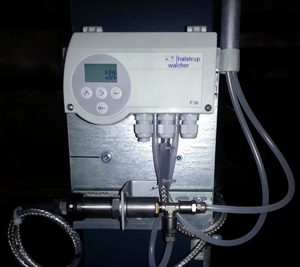The Volkswagen plant in Emden is a busy place. Located in the East Frisian region of Germany’s northwest coast, the facility and its over 8,000 employees will pass two major milestones this year, each of which would have produced considerable activity on its own: the new Passat B8 is on its way, and the plant will be celebrating its 50th anniversary in 2014.
 The volume flow is recorded by the highly precise P26 differential pressure transmitter from halstrup-walcher
The volume flow is recorded by the highly precise P26 differential pressure transmitter from halstrup-walcher
The atmosphere in the plant’s gigantic paint shop, however, is one of professional calm. The 1,200 cars that enter here each day leave as high-gloss versions of themselves in every conceivable colour. Detert Ackermann, who helps maintain the finishing lines, sums it up like this: “We know that we’ve got the perfect touch when it comes to both the cost and quality of the paint job.”
Ackermann proudly presents “his” finishing line. The clear highlights of the line are the curing ovens, which bake the finishing layer previously applied by painting robots. Vehicle bodies first pass through two radiant heating zones before entering the next three zones, where recirculating air produces a high-gloss finish that will last for many years.
“The painting process generates over forty percent of the energy costs at an automotive plant,” says Ackermann. “So this was where we focused our work with Crone Wärmetechnik, an equipment builder from Rhauderfehn, Germany, and with CVET of Clausthal, Germany. The collaboration produced huge savings in the curing and drying process!” From a technical perspective, the process has two outcomes: it provides the ovens with thermal energy, while eliminating the harmful substances in the oven waste gas that pose a hazard to human health and to the environment. The entire process must keep costs at a minimum without sacrificing the quality of the finish.
Post-combustion techniques have been used for many years to minimize paint residues in waste gas, and the recuperators employed for this job are optimized with respect to their energy balance. Recovering the waste heat from the post-combustion process and using it to preheat the oven intake air represents yet another important way of helping minimize consumption.
The concept was the code-named LAVA (a German acronym for load-dependent volume flow adjustment) and refined still further, with additional savings focusing primarily on the air volume flow through the ovens. Classic paint-baking ovens and post-combustion equipment are operated at a constant volume flow, which is always set for the maximum load. The maximum load, in this case, refers to the (maximum) number of vehicle bodies to be dried per day. The LAVA approach, however, involves adjusting the volume flow to match the current load. After all, the number of bodies to be painted is not the same every hour of the week. “In other words, we regulate the volume flow in response to the load,” explains Ackermann, who provided project support.
In concrete terms, this means that less air flows through the system when loads are light, which in turn decreases the amount of air – and the paint residues it contains – returned to the recuperator to be treated. While this reduces the power consumed by the fans, it also generates huge savings by cutting the amount of natural gas used in the recuperator. During its over 12 months of operation at the VW plant in Emden, the system has generated impressive savings of 25 percent – a figure achieved without compromising the quality of the finish.
All of the equipment parameters are measured and visualized online, as is the key variable: air volume flow. Due to the high temperatures involved in this process – at times exceeding 300°C – volume flow was measured with a dynamic pressure probe, using a method based on differential pressure. According to Andreas Scherer, who heads the Electrical Engineering Department at Crone Wärmetechnik, “We do business with a company that regularly has sophisticated measuring problems to solve, and they recommended halstrup-walcher’s measurement solutions to us. The measurement point setup, on-time delivery and – most of all – the company’s ongoing follow-up were all absolutely flawless. What impressed us most of all was the automatic zero-point correction that the P26 differential pressure transmitter regularly carries out with the aid of magnetic valves. That keeps the measured value completely stable for many years without having to be adjusted. I was also impressed by the system’s resistance to overload, which prevents pressure spikes from having any impact on the sensor system.”
A family-owned business in Kirchzarten, Germany, halstrup-walcher specializes in technology for measuring pressure and volume flow. In addition to supporting classic differential pressure applications such as filter and fan monitoring, the company also dedicates much of its energies toward sophisticated measurement tasks such as maintaining overpressure in cleanrooms and measuring volume flow in climate-control and processing applications. Rounding out this portfolio are halstrup-walcher’s accredited in-house calibration laboratory and the calibration services that the company provides at its customers’ sites.
The paint shop operator is extremely pleased with the results of collaboration with halstrup-walcher as well. As Ackermann observes, “We haven’t had any problems with our volume flow measurements since we started up over a year ago. I take a look at the values most days, often several times a day. The results are always completely plausible and stable too – kudos to halstrup-walcher and to our dependable equipment builder Crone!”
Bring on the new Passat. Detert Ackermann and his team are ready. What especially motivates them is knowing that they can help the VW plant in Emden achieve an attractive cost structure – their contribution to many company anniversaries to come.